Auto Market Mid-Year Report: Groups Showcase Integration Strategies, Joint Ventures Rebound, and Huawei Versus Xiaomi in New Energy Race
![]() 07/03 2025
07/03 2025
![]() 891
891
As July begins, the auto market's fervor reaches new heights.
In the past few days, automakers have successively unveiled their June sales reports, alongside the "mid-term exam" results for the first half of 2025, with an array of impressive data flooding the screens.
At the vehicle group level, BYD and SAIC Group both surpassed the 2 million vehicle mark, while FAW Group, Chery Group, Changan Automobile, and Geely Automobile form the "million-vehicle club," demonstrating the robust strength of leading enterprises.
In the new energy sector, XPeng, Leapmotor, and Li Auto have joined the "half-year 200,000-vehicle club," while Xiaomi Automobile and Hongmeng Zhixing have surged to new heights. The sales of some "second-generation factories" (Haval, Deep Blue, AITO, and Weiying, among others) have also seen significant increases.
In the joint venture sector, sales of FAW-Volkswagen, FAW Toyota, and SAIC-GM have rebounded, indicating that traditional joint venture brands have made adaptive improvements in market adjustments.
These early-released data are truly impressive. In contrast, frequently discussed narratives about consumer downgrading, market chill, and difficulty in profitability seem somewhat overshadowed.
Behind these impressive figures, the turmoil and war-like atmosphere of the first half should not be forgotten: price wars left the industry battered, and public opinion battles flared up one after another; the aftermath of NIO's explosion has yet to subside, and voices of consumer rights protection persist; intelligent driving, once universally praised, suddenly hit the brakes; behind the joint commitment of over 17 automakers to "no payment period exceeding 60 days" lies the collective anxiety of upstream and downstream industries...
Some players stand firm in the tide, while others struggle in the corner. This is the brutal logic of competition. Moreover, the speed of reshuffling in China's auto industry is faster than imagined.
Vehicle Group's Major Integration Strategies
On July 1, vehicle groups' half-year sales reports appeared more intensely than in previous years. Behind this lies a special significance – these numbers are actually the first-stage reform report card after the major integration that has swept the entire industry since 2024.
In 2024, Chinese auto groups collectively entered the year of structural adjustment. From brand operations to industrial chain technology, from organizational structure to management mode, each group has promoted reforms centered around strengthening integrated strength.
For example, 2025 is the first year of GAC Group's three-year "Panyu Action" and the start of integrated operation of its independent brands.
SAIC Group's large passenger vehicle sector adjustment began with a major personnel reshuffle in August 2024, with changes at the senior levels of SAIC-GM, SAIC Volkswagen, and SAIC Passenger Vehicles, laying the groundwork for subsequent integration. At the beginning of 2025, a large passenger vehicle executive management committee was also established to coordinate the domestic and overseas businesses of brands such as Roewe, MG, and Feifan, attempting to solve the pain point of multiple brands competing against each other.
The two first-tier state-owned auto enterprises, FAW Group and Dongfeng Motor, have entered a period of organizational structure system reform since last year. For example, on the last day of 2024, Dongfeng Motor announced adjustments to its headquarters functional departments, promoting the transformation of the company headquarters from strategic control to operation + coordination, and further integrating the group's resources to operate its independent passenger vehicle business.
Leading private auto company Geely Automobile is also doing the same. On January 5 of this year, Geely Holdings initiated the "133" strategy, which follows the "Taizhou Declaration" as a general guideline and transforms around three major directions: organization and culture, competitiveness, and management mode, strengthening the three major segments of vehicle business, core components, and ecological business. Link&Co and Zeekr have combined to form Zeekr Technology Group.
After the system adjustment is settled, the market will ultimately use numbers to prove which company's integration truly breaks down barriers, which company's restructuring hits the industry's pain points, and who seizes the initiative in this system strength competition.
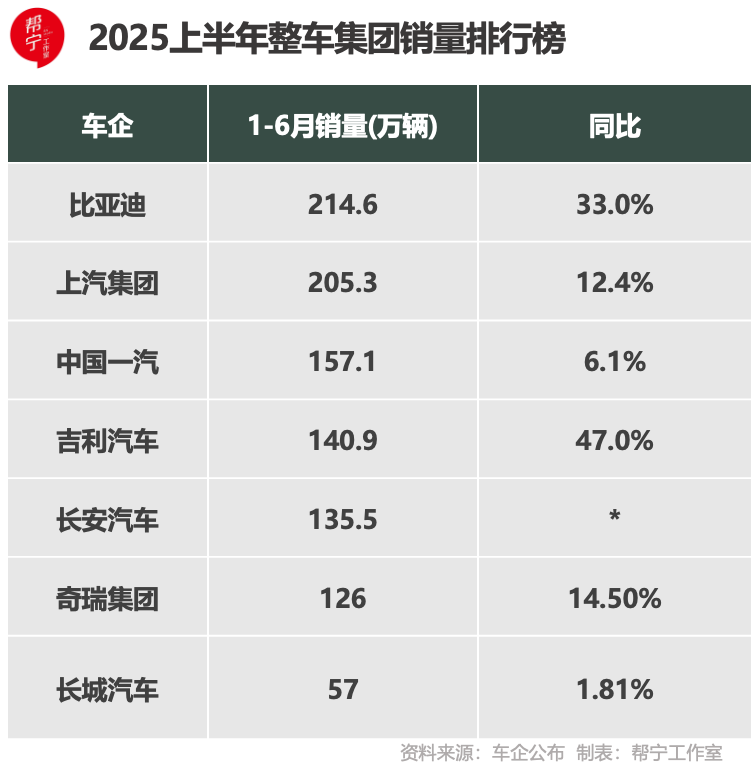
The data released for the first half of 2025 has thus become a mirror to test the effectiveness of these reforms. Judging from the positive year-on-year growth rates, the reforms of each group have shown initial results, but there are significant differences in the depth and pace of change – some enterprises are accelerating the release of integration dividends, while others are still in the energy accumulation period of efficiency transformation.
BYD and SAIC Group can be called the "top two." The former slightly outperforms with a half-year sales volume of 2.146 million vehicles (up 33.04% year-on-year), continuing to lead the pack; while the latter demonstrates the profound accumulation of a veteran, with 2.053 million wholesale vehicles in the first half (up 12.4% year-on-year), only about 100,000 less than BYD, but SAIC Group's terminal retail deliveries reached 2.207 million vehicles, achieving an overtake in this regard.
Behind this achievement is the "three-pronged" effort of SAIC after its reform: independent brands achieved sales of 1.304 million vehicles, up 21.1% year-on-year, with the proportion increasing to 63.5%; new energy vehicles totaled 646,000 units, surging 40.2% year-on-year; and overseas markets grew against the trend by 1.3% to 494,000 units, with the synergistic effect of integrated integration continuing to emerge.
The sales of major products and the growth data of overseas markets in SAIC's battle report are a direct reflection of the efficiency of architectural integration.
Now let's look at the million-vehicle club. Here, the "close-quarters combat" is fierce, with FAW Group, Geely Automobile, Changan Automobile, and Chery Group achieving sales of 1.57 million, 1.4092 million, 1.355 million, and 1.26 million vehicles in the first half, respectively.
FAW Group's total vehicle sales in the first half increased by 6.1% year-on-year. Among them, the Hongqi brand sold over 52,000 vehicles in June alone, up 29.6% year-on-year; sales from January to June exceeded 225,000 vehicles, up 11.8% year-on-year, steadily leading the independent luxury brand camp. Joint venture brand sales reached 1.121 million vehicles, maintaining a leading position in the joint venture camp.
Changan Automobile sold 1.355 million vehicles in the first half of this year, a new high in the past eight years. Among them, new energy vehicles totaled 450,000 units, up 48.8% year-on-year, highlighting the effectiveness of the transformation.
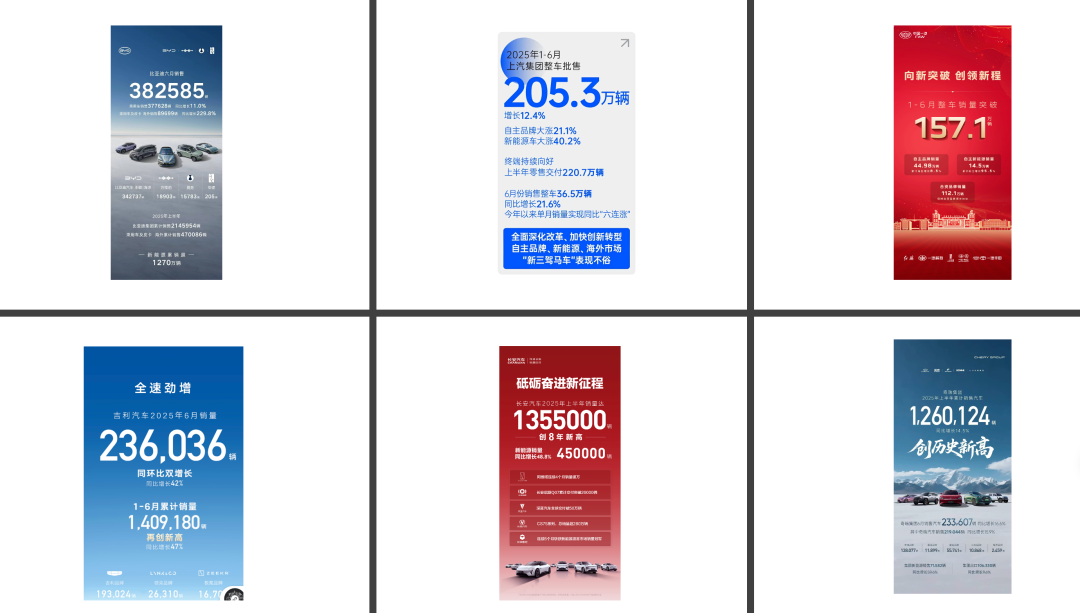
With a year-on-year growth rate of 47%, Geely Automobile has become the dark horse of this camp and has therefore ambitiously raised its annual sales target from 2.71 million to 3 million vehicles, demonstrating confidence in the effectiveness of reforms.
From January to June, Chery Group achieved growth in sales, exports, new energy, and technology, delivering a high-quality development answer.
Another private giant, Great Wall Motor, sold 569,800 vehicles in the first half, up 1.81% year-on-year, performing steadily. Among them, 36,400 new energy vehicles were sold in June, and 160,400 were sold from January to June. In June, 40,100 vehicles were sold overseas, and 197,700 were sold from January to June.
As of press time, GAC Group and Dongfeng Motor have not released their group sales for the first half.
As industry rules show, the essence of competition among large vehicle manufacturers is a marathon that compares systemic capabilities: in the short term, it looks at product iteration and sales sprints; in the medium term, it looks at technological breakthroughs and supply chain resilience; in the long term, it depends on the depth of ecological construction and global layout.
In this competition centered on system strength, only enterprises that maintain advantages in multiple dimensions simultaneously can remain at the forefront in the industry reshuffle, and any weakness in any link may become a breakthrough for competitors to surpass.
Joint Venture Auto Company Adjustment and Recovery
After a period of adjustment, the recovery trend of joint venture auto companies is gradually becoming clear.
On July 1, leading joint ventures such as FAW-Volkswagen, FAW Toyota, and SAIC-GM collectively disclosed the latest sales data, all achieving month-on-month growth, indicating the overall positive momentum of this sector – this upsurge indicates the phased results of the "oil and electricity advancement" strategy implemented by joint venture auto companies.
In the first half, FAW-Volkswagen sold 436,133 vehicles, up 3.5% year-on-year, becoming the flag bearer in the recovery wave of joint venture auto companies.
In June, its total vehicle sales were 160,100 units (including imported vehicles), up 15.1% year-on-year. Among them, 87,000 Volkswagen brand vehicles were delivered, up 12.5% year-on-year; 61,000 Audi vehicles (including imported vehicles) were delivered, up 15.7% year-on-year; and 12,100 Jetta vehicles were delivered, up 33.4% year-on-year.
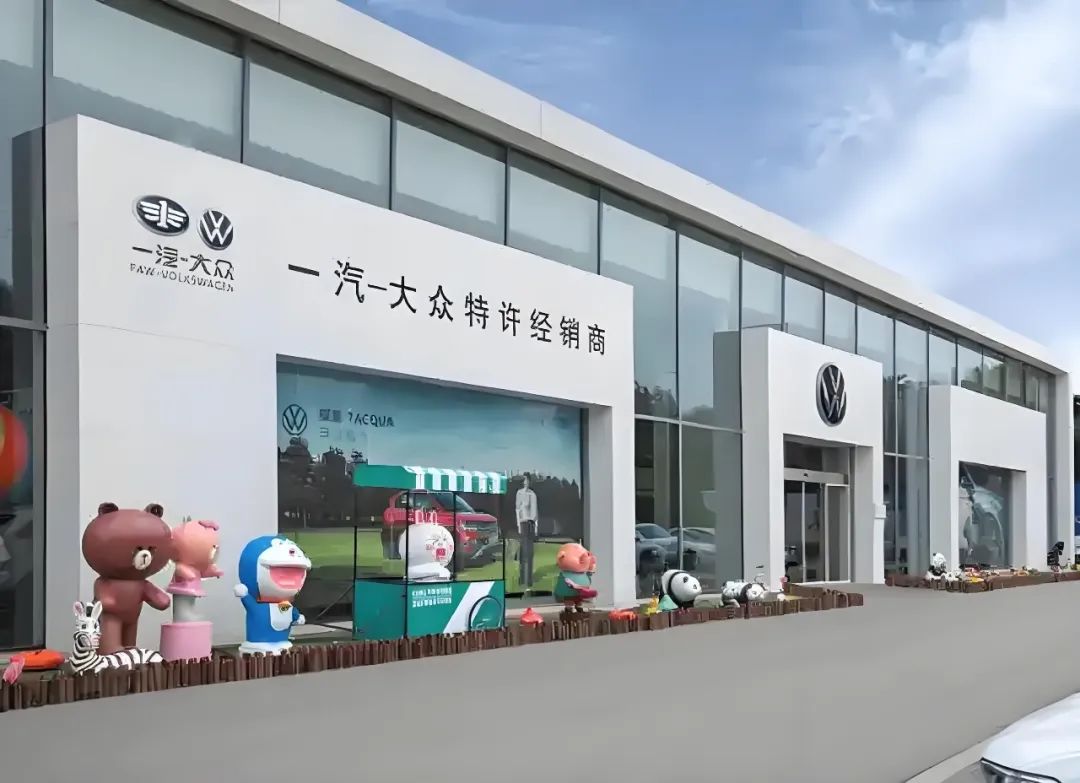
FAW Toyota sold 377,821 new vehicles from January to June, up 16% year-on-year. In addition to the continuously lengthening record of positive growth in sales, there were two important events for FAW Toyota in the first half.
First, the 12 millionth new vehicle of FAW Toyota rolled off the production line in May, marking a new journey for FAW Toyota's development and making it one of the few automakers in the industry to reach this scale.
Second, in June, FAW Toyota's sales company relocated from Beijing to Tianjin, the first cross-provincial relocation in its 22-year history. This will shorten the communication links between the sales company and the headquarters, production, and research, thereby building an integrated research, production, and sales mechanism guided by the market, and promoting product iteration and renewal in a more flexible and faster manner, enriching the product matrix and enhancing product competitiveness.
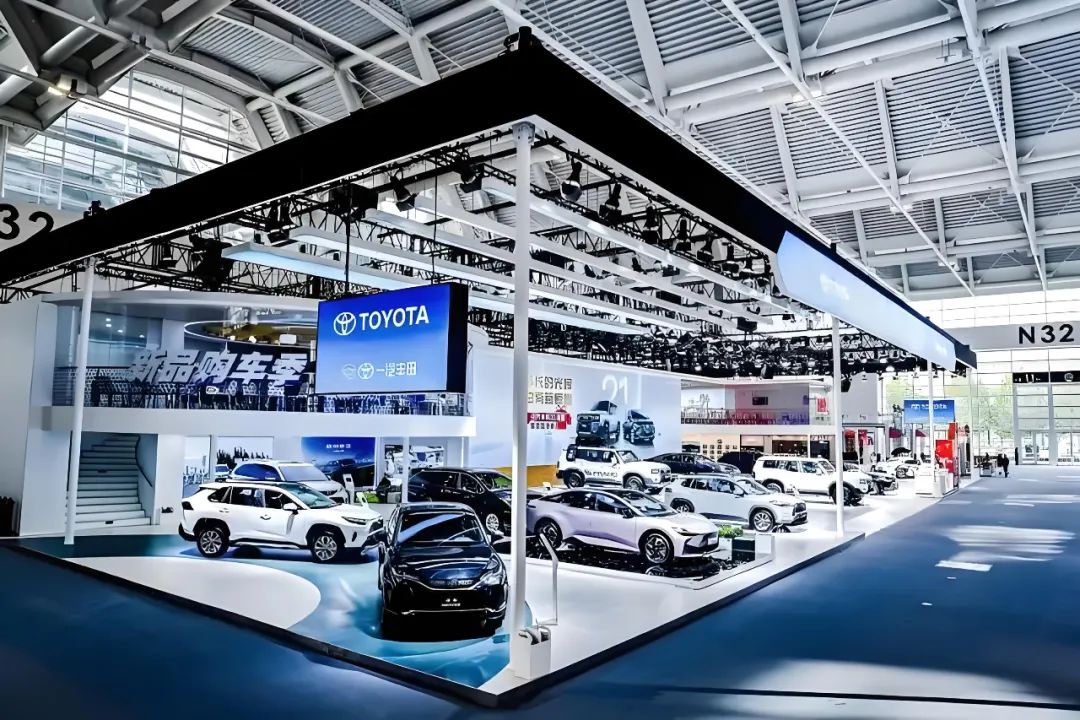
In addition, SAIC-GM sold 48,675 vehicles in June, up 7.6% year-on-year.
Judging from their sales structure, the basic disk of fuel vehicles is stable, constituting the cornerstone of their growth.
For example, FAW-Volkswagen's sales in June increased by 15.1% year-on-year, with main fuel models such as Sagitar, Magotan, and Tiguan continuously occupying the top positions in the segment market. From January to June, its market share of fuel vehicles increased by 0.7 percentage points year-on-year, demonstrating its accumulation in the traditional fuel field.
SAIC-GM's classic models such as the Buick GL8 and Envision remain strong. Envision Plus saw a year-on-year increase of nearly 200% in the first half, indicating that there are still structural opportunities in the fuel vehicle market.
At the same time, joint venture auto companies are accelerating their electrification transformation to inject new momentum into growth.
In the first half, FAW Toyota's sales of electrified models accounted for 49%, indicating that nearly half of its sales came from new energy; SAIC-GM's new energy terminal sales in June increased by 13.2% year-on-year, and although the base is still low, the direction of transformation is clear; FAW-Volkswagen has planned to launch 10 new energy and hybrid models from 2026, deploying a diversified power route.
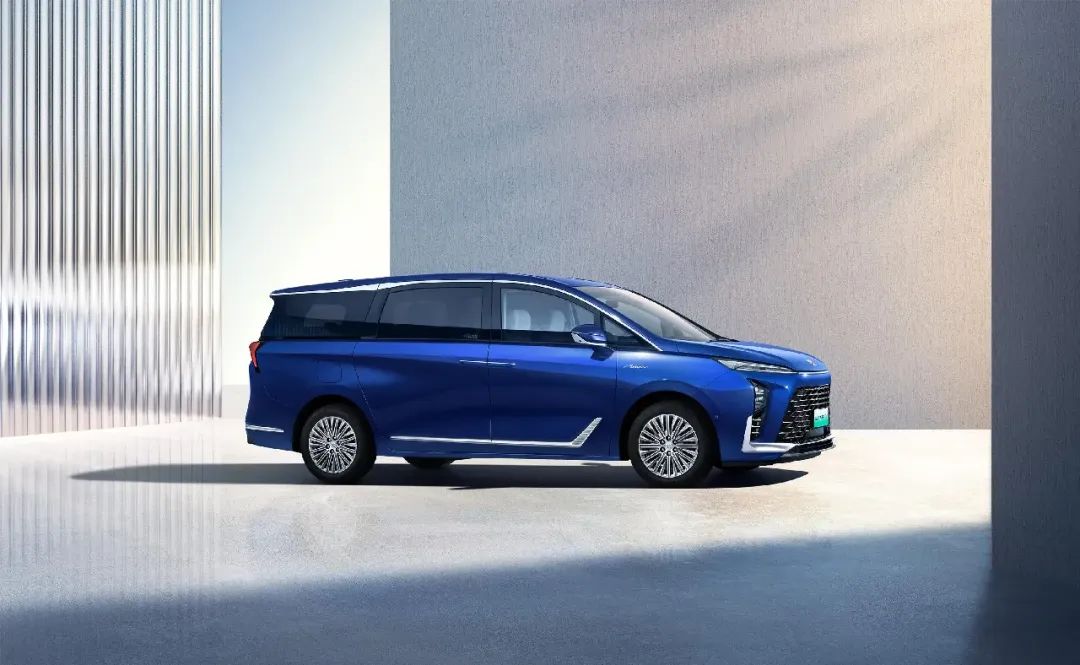
These data reveal the dual strategy of joint venture auto companies: on the one hand, they consolidate the stock market in the fuel vehicle field by virtue of brand heritage and product reputation; on the other hand, they accelerate electrification and intelligent transformation, and seize the incremental racetrack through organizational structure adjustment and product matrix optimization.
However, against the backdrop of the continuous rise in new energy penetration rates, whether joint venture auto companies can convert phased growth into long-term competitiveness remains to be tested by the market.
Huawei and Xiaomi Dominate the "New" Racetrack
On June 26, Xiaomi Automobile once again threw a bombshell – the new car YU7 started at 253,500 yuan, and it ignited the market upon its launch: more than 200,000 orders were placed within 3 minutes, surging to 289,000 within 1 hour, and the locked order volume soared to 240,000 within 18 hours...
This set of data refreshes the opening sales record of China's auto industry. For example, its 18-hour locked order volume exceeds the total sales of all new forces in May, like dropping a shock bomb in the new force camp, allowing Xiaomi YU7 to firmly control the 250,000-yuan SUV market.
Data shows that Xiaomi Automobile's June deliveries continued to gain momentum, with over 25,000 vehicles delivered from the SU7 model alone; as of the end of June, cumulative deliveries of the SU7 series have exceeded 250,000 vehicles.
However, when it comes to dominance in the high-end market, Hongmeng Zhixing takes the cake.
In June, Hongmeng Zhixing delivered 52,747 vehicles across its entire line-up, with a single-day peak delivery of 3,651 vehicles, both refreshing the brand's historical records. It also set the fastest delivery record for new forces with 800,000 cumulative deliveries in 39 months. From the perspective of the market landscape, Hongmeng Zhixing firmly stands in the 400,000 to 1 million yuan market.
Hongmeng Zhixing's "five realms" strategy may have hit its ceiling, signaling a shift towards refined operations within its cooperation system.
Xiaomi swiftly opens market gaps with its pricing and traffic strategies, while Hongmeng Zhixing solidifies its high-end presence through ecosystem integration and multi-brand synergy. The competition dynamics in the emerging market are being reshaped by these two players and their distinct models.
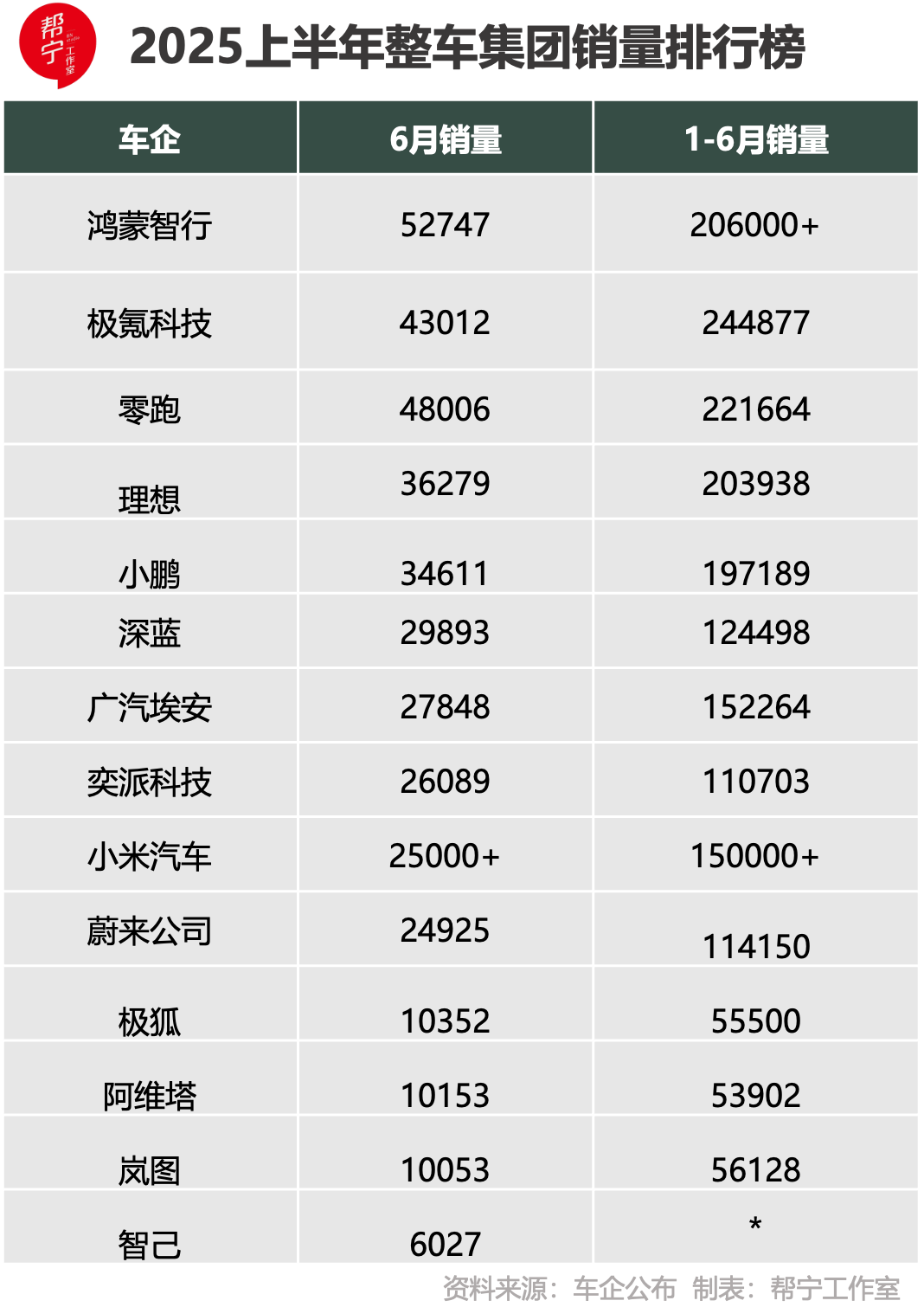
Li Auto might be the first to feel the pinch.
Data reveals that Li Auto delivered 36,279 vehicles in June and 111,074 vehicles in Q2, marking a 24% year-on-year decline and an 11.2% drop from the previous month. This is the first annual delivery decline in recent years.
As Li Auto celebrates its 10th anniversary, boasting achievements like "over 1.33 million cumulative deliveries in five years, consecutive sales champion in the mid-to-high-end market above 200,000 yuan for Chinese brands, and annual revenue exceeding 100 billion yuan," it now faces challenges from Hongmeng Zhixing's ecological push, Xiaomi Automobile's market disruption, and numerous competitors claiming to be "half-price Li Auto."
NIO, with a multi-brand strategy, is accelerating its growth. It delivered 24,900 vehicles in June, a 17.5% increase year-on-year, with both Ledao and Firefly achieving new monthly sales highs. In Q2, NIO delivered 72,100 new vehicles, up 71.2% from the previous month, marking its second-best quarterly performance ever.
On the other hand, ZEEKR showed slight weakness, with June sales of 16,700 vehicles, down 16.94% year-on-year. Monthly sales have yet to surpass 20,000 vehicles this year, gradually widening the gap with mainstream new players.
Meanwhile, 'second-generation' brands continue to make breakthroughs in niche markets.
Voyah has excelled in the MPV segment, with June sales of 10,053 vehicles (up 83% year-on-year) and cumulative sales of 56,128 vehicles in H1 (up 85% year-on-year). Notably, Dreamer topped the national MPV sales chart in the third week of June with 2,720 vehicles sold, winning both the new energy MPV and high-end MPV crowns, surpassing traditional joint venture competitors.
AITO sold 10,153 vehicles in June (up 117% year-on-year), marking the fourth consecutive month with sales exceeding 10,000. Relying on over 700 channel touchpoints across more than 200 cities and its 'No. 1 Project' for customer service, AITO continues to improve its market penetration.
After four years, Great Wall Motors' high-end brand WEY finally saw monthly sales exceed 10,000 again in June. Regarding this long-awaited milestone, WEY stated, "For us, this is not just a numerical leap but the start of a new responsibility." Clearly, WEY has been waiting for this moment for a long time.
Reviewing H1 sales, it's evident that competition among new players has long surpassed single-dimensional battles. Some compete on price, while others break into niche markets. The combined strength of HarmonyOS Intelligent Drive and Xiaomi Automobile is pushing the industry into a decisive phase.
Entering Q3, the automobile market is akin to scorching weather, with intense competition, transformation pressures, export challenges, and other 'high temperatures' all converging. Each automaker is facing a tough test, with sales fluctuations, product development breakthroughs, and supply chain stability placing them in a crucible of continuous refinement, akin to a hellish ordeal.
What the Chinese automobile market is now competing for is not short-term sprint capabilities but who can endure the hardships step by step with greater system resilience and strategic determination in this 'baking' test.
This summer, for all automakers, the priority might not be blind acceleration but learning to hold an umbrella – while maintaining fundamentals, they must also fortify defenses in technology reserves, healthy cash flow, user trust, etc. Only then can they retain the confidence to move forward once the heatwave subsides.







